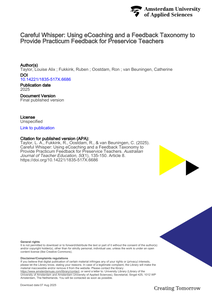SummaryA question that received considerable interest from language teachers and researchers alike is what corrective feedback (CF) should look like to be maximally beneficial to learners’ second language development. This chapter zooms in on two feedback types that have been distinguished in the CF literature: focused and unfocused CF. After a careful characterization of these two feedback options, theoretical, methodological, and pedagogical arguments are discussed for both of them. The chapter furthermore provides a synthesis of oral and written feedback studies into the (relative) value of focused and unfocused CF. It concludes with suggestions for further research and implications for L2 classrooms.
DOCUMENT
Many institutes for initial teacher education struggle to organise effective performance feedback within the context of student teaching practicum. As the cooperating teachers who provide this feedback bring their individualised ontologies, feedback practices have been characterised by inconsistencies in the amount and quality of performance feedback. In this small-scale study carried out in the Netherlands, we explored affordances of eCoaching using a standardised feedback taxonomy. With the help of Bluetooth technology and the Synchronous Online Feedback Taxonomy, four teacher educators provided eCoaching to eight preservice teachers over the course of three lessons. We interviewed teacher educators and preservice teachers about their experiences with eCoaching using the feedback taxonomy during secondary school practicum. Overall, both groups of participants were positive about eCoaching using the taxonomy. Teacher educators observed preservice teachers self-regulating when implementing prior feedback in their lessons. Preservice teachers indicated increased confidence following the lessons with eCoaching.
DOCUMENT

In higher education, students often misunderstand teachers’ written feedback. This is worrisome, since written feedback is the main form of feedback in higher education. Organising feedback conversations, in which feedback request forms and verbal feedback are used, is a promising intervention to prevent misunderstanding of written feedback. In this study a 2 × 2 factorial experiment (N = 128) was conducted to examine the effects of a feedback request form (with vs. without) and feedback mode (written vs. verbal feedback). Results showed that verbal feedback had a significantly higher impact on students’ feedback perception than written feedback; it did not improve students’ self-efficacy, or motivation. Feedback request forms did not improve students’ perceptions, self-efficacy, or motivation. Based on these results, we can conclude that students have positive feedback perceptions when teachers communicate their feedback verbally and more research is needed to investigate the use of feedback request forms.
MULTIFILE
